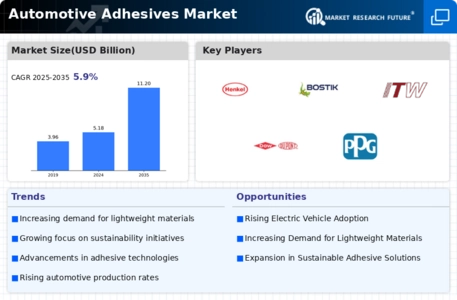Top Industry Leaders in the Automotive Adhesives Market

The rumble of engines and the gleam of metal may capture the spotlight, but behind the scenes of every sleek car and sturdy truck lies a silent hero: the automotive adhesive. These specialized glues bind together diverse materials, from lightweight aluminum to high-strength steel, forming the unseen backbone of modern vehicles. The global automotive adhesives market is a bustling arena where established giants and agile innovators vie for a share, wielding innovative strategies and cutting-edge formulations to cement their positions in this dynamic, high-stakes race.
Strategies Fueling Market Growth:
-
Technological Twists: R&D labs are buzzing with innovation. Leading players like Henkel are pioneering low-VOC and fast-curing adhesives for streamlined production, while 3M is developing self-healing adhesives that repair minor cracks, extending vehicle lifespan and reducing maintenance costs.
-
Sustainability Focus: Green bonds are forming. Companies like DowDuPont Inc. are investing in research and development of bio-based adhesives derived from renewable resources like soybeans, aligning with environmental concerns and regulations.
Material Diversification: Beyond the standard epoxy and polyurethane options, companies like Sika AG are tailoring adhesives for specific material combinations, like aluminum-to-steel bonding, catering to the evolving needs of lightweight vehicle construction. -
Regional Expansion: Asia-Pacific, with its booming automobile production, holds immense potential. Companies like H.B. Fuller are setting up production facilities in this region to capitalize on the local demand.
-
Strategic Partnerships: Collaboration strengthens the bond. For instance, Bostik partnered with a leading electric vehicle manufacturer to develop customized heat-resistant adhesives for battery packs, cementing both companies' positions in the rapidly growing EV market.
Factors Dictating Market Share:
-
Performance Prowess: Superior bond strength, flexibility, durability, and resistance to heat, vibration, and chemicals are crucial metrics. Established brands like Huntsman Corporation have built reputations for reliable performance, attracting loyal customers in critical automotive applications like structural bonding and engine components.
-
Cost-Effectiveness: Price remains a sticky point, particularly in mature markets. Chinese manufacturers often offer lower prices, challenging established players to optimize production and pricing strategies while maintaining quality.
-
Regulatory Landscape: Stringent regulations on volatile organic compounds (VOCs) and hazardous materials dictate industry practices. Players who comply with these regulations, like Akzo Nobel with its closed-loop recycling systems, gain a competitive edge.
-
Application Diversity: Catering to diverse vehicle components and assembly processes offers resilience. Companies with broad product portfolios like Illinois Tool Works benefit from diversification, mitigating risks in specific segments.
Key Players:
-
3M (US)
-
Henkel & Co. KGaA (Germany)
-
H.B. Fuller Company (US)
-
BASF SE (Germany)
-
Bostik (US)
-
Illinois Tool Works Inc. (US)
-
DowDuPont (US)
-
Sika AG (Switzerland)
-
PPG Industries (US)
-
Solvay S.A (Belgium)
-
Jowat AG (Germany)
-
Akzo Nobel N.V. (the Netherlands)
Recent Developments:
- July 2023: Henkel unveils its low-VOC, fast-curing epoxy adhesive for automotive interiors, offering streamlined production and reduced environmental impact.
- August 2023: 3M successfully commercializes its self-healing polyurethane adhesive for car bumpers, promising reduced repair costs and enhanced vehicle aesthetics.
- September 2023: DowDuPont Inc. introduces a line of bio-based adhesives for interior trim panels, catering to eco-conscious consumers and reducing reliance on petroleum-based materials.
- October 2023: Sika AG develops a high-strength adhesive specifically designed for aluminum-to-steel bonding in car bodies, enabling lightweighting and improved fuel efficiency.

